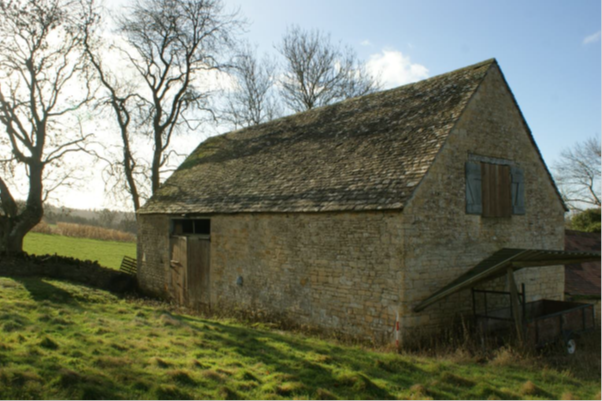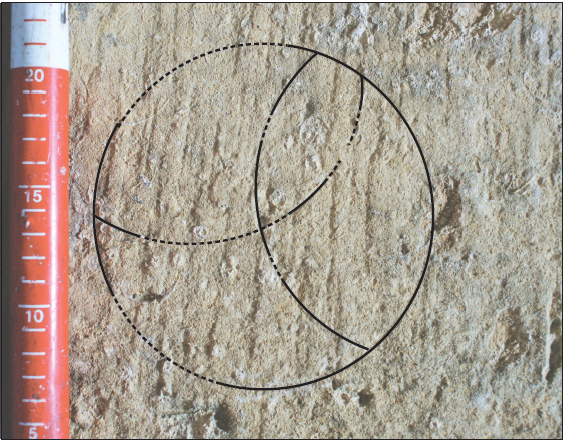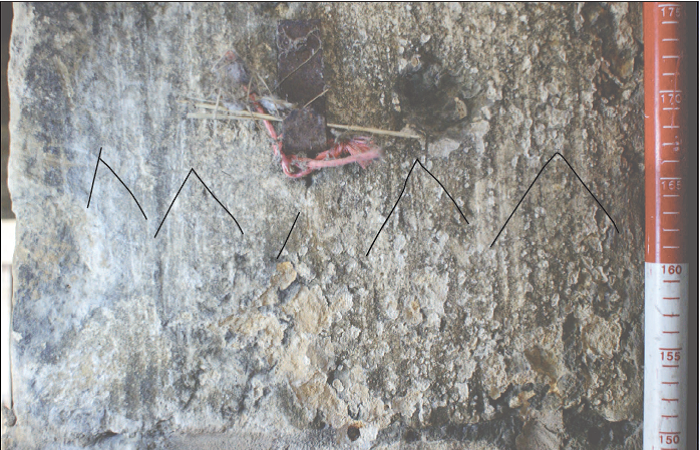Broomsticks over Broadway
- 30th October 2017
In the first of two posts with a spooky flavour for Halloween we’re taking a look at some ritual symbols intended to ward off witches and evil spirits that were discovered earlier this year in a barn in south Worcestershire.
In January 2017 buildings archaeologist Tim Cornah went out to investigate a group of farm buildings at Broadway Tower Country Park that are being converted to provide a new visitor centre, kitchen facilities and bike hire reception.

Covert Hill Barn
The earliest building Tim recorded was a barn dating from the 18th or early 19th century, named on an Ordnance Survey map of 1884 as Covert Hill Barn. It would have been used for threshing wheat and storing hay or straw and its users had protected it with a series of enigmatic ritual symbols called apotropaic marks. This word comes from the Greek word apotropaios, meaning averting or turning away evil, but they are more commonly known as witch marks!
These symbols were used from the Middle Ages into the early 19th century, a time when belief in witchcraft and the supernatural was common, and were usually carved on or near the entrance points to a building, particularly doorways, windows and fireplaces, to protect the inhabitants and visitors from witches and evil spirits. At Tower Barn they took the form of marks cut into the stone around the threshing floor doors on the eastern side of the building.
The first of these was a symbol known as a daisy wheel, which was used to bring good luck and as a general protection against misfortune. Daisy wheels comprise a single, endless line which supposedly confused and entrapped evil spirits.

The daisy wheel symbol – the mark has been drawn-over in the picture to make it easier to see.
Above this was another set of fainter marks representing a series of inverted V or M symbols. These are known as Marian marks and have been found in other threshing barns. They are thought to mean Virgo Virginum or Virgin of Virgins, and Mary Mother of Jesus, invoking her protection.

The Marian marks – these have also been drawn-over to make them easier to see.
On the south side of the doorway was a possible saltire cross. These have been recorded on what are called locally in Yorkshire ‘witch-posts’, where they were associated with itinerant catholic priests who would use it as a ‘secret’ mark to identify a place where mass was held. At Broadway a simpler explanation may be that it was a crude blessing on the barn. A final set of marks are likely to have been a simple tally or count of the number of cart loads of wheat brought into the barn for threshing at harvest time.
The witch marks at Tower Barn help us to understand how previous generations saw the world, their beliefs, and the fear of the supernatural that they held. The use of the inverted V or M and the saltire cross might also suggest that Catholic traditions invoking the power of the Virgin Mary were still held amongst some people in the local area in 18th or early 19th century.
Witch marks can be found in other buildings in the county, some of which can be visited. The National Trust-owned Fleece Inn at Bretforton has a series of witch marks on the inside of the front door while, in the continuation of a medieval tradition, chalk circles are still drawn on the floor in front of the hearths to prevent witches and evil spirits coming down the chimney! Marian marks have been recorded at Prince Arthur’s Chantry in Worcester Cathedral, while daisy-wheels can be seen in the porch of All Saints Church and the Abbey Bell Tower at Evesham.
At Harvington Hall, near Kidderminster, a series of overlapping circles have been scratched into a sealed door that once led into a now-demolished part of the building. Perhaps the owners sealed and marked the door in fear that “Something wicked this way comes”…
You can read more about some other discoveries of witch marks in Worcestershire via links to previous posts on Explore the Past:
Wonderful !
And right on my doorstep